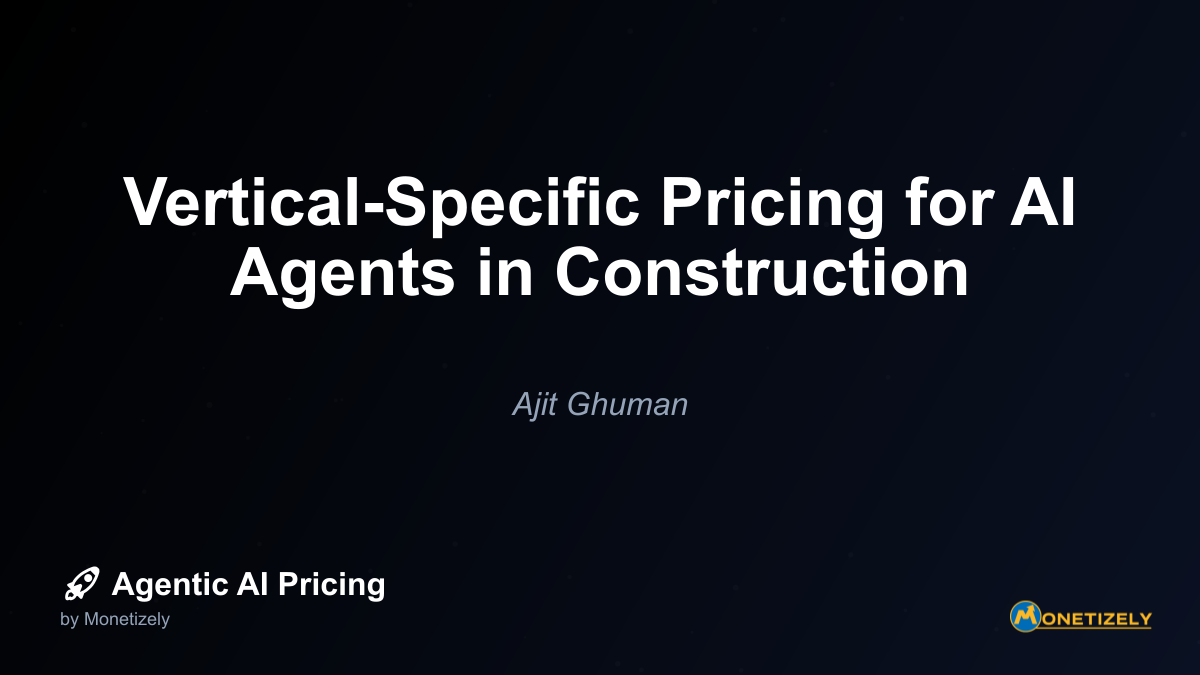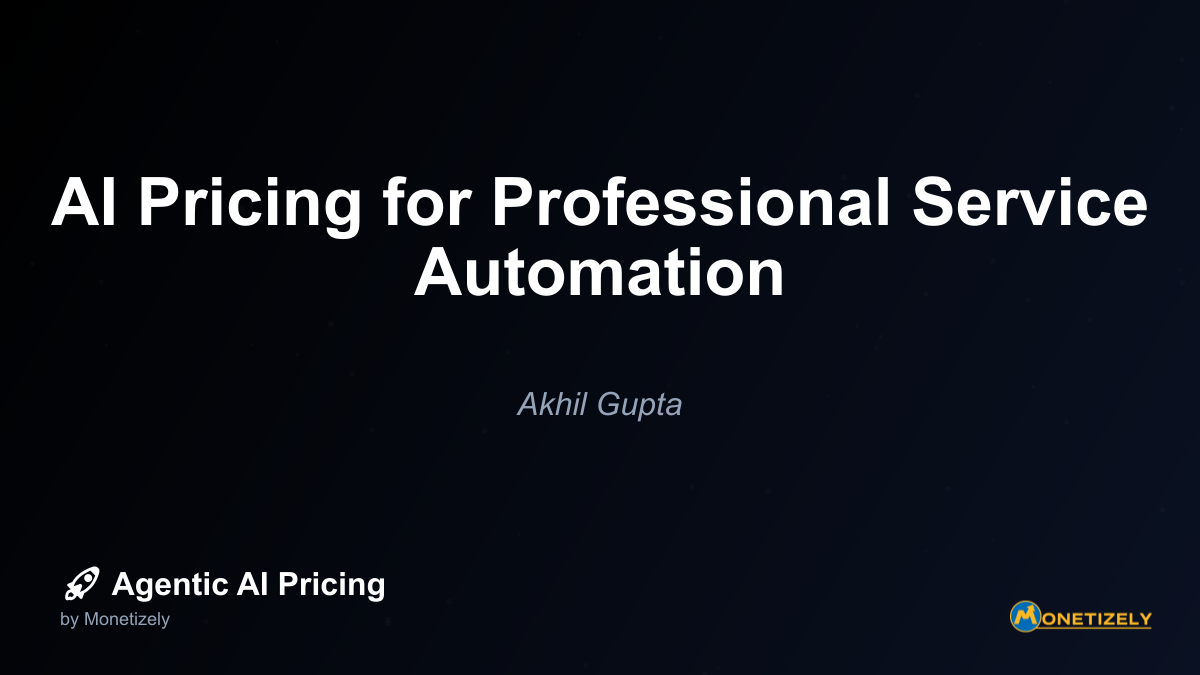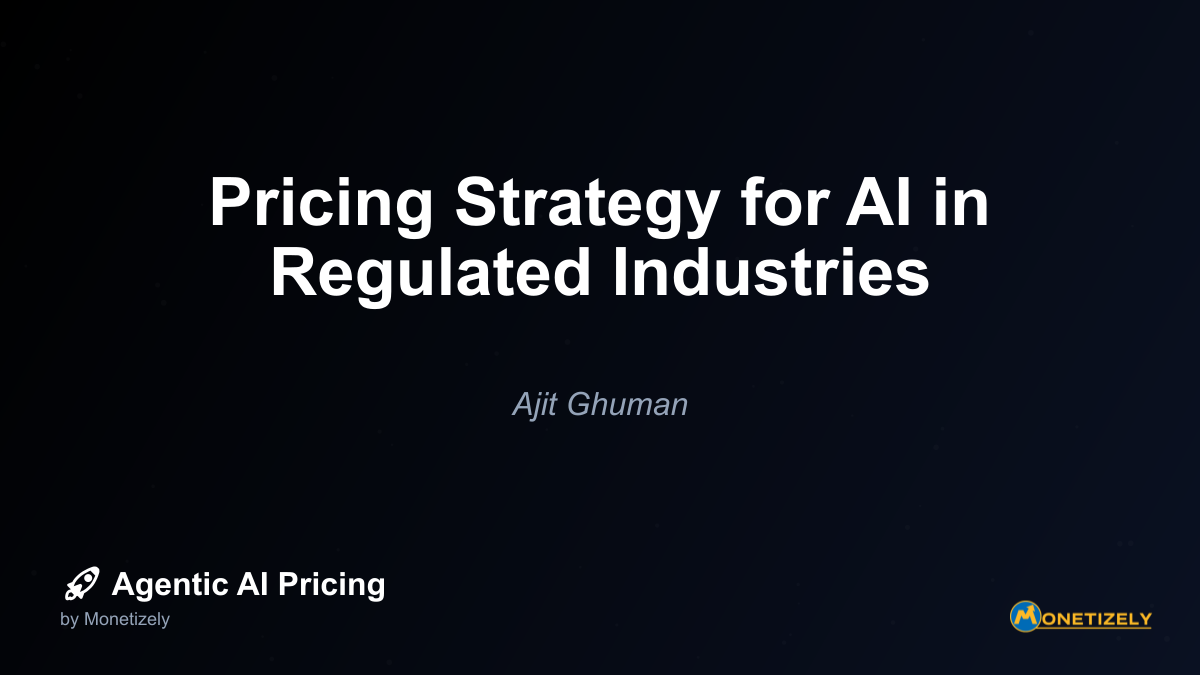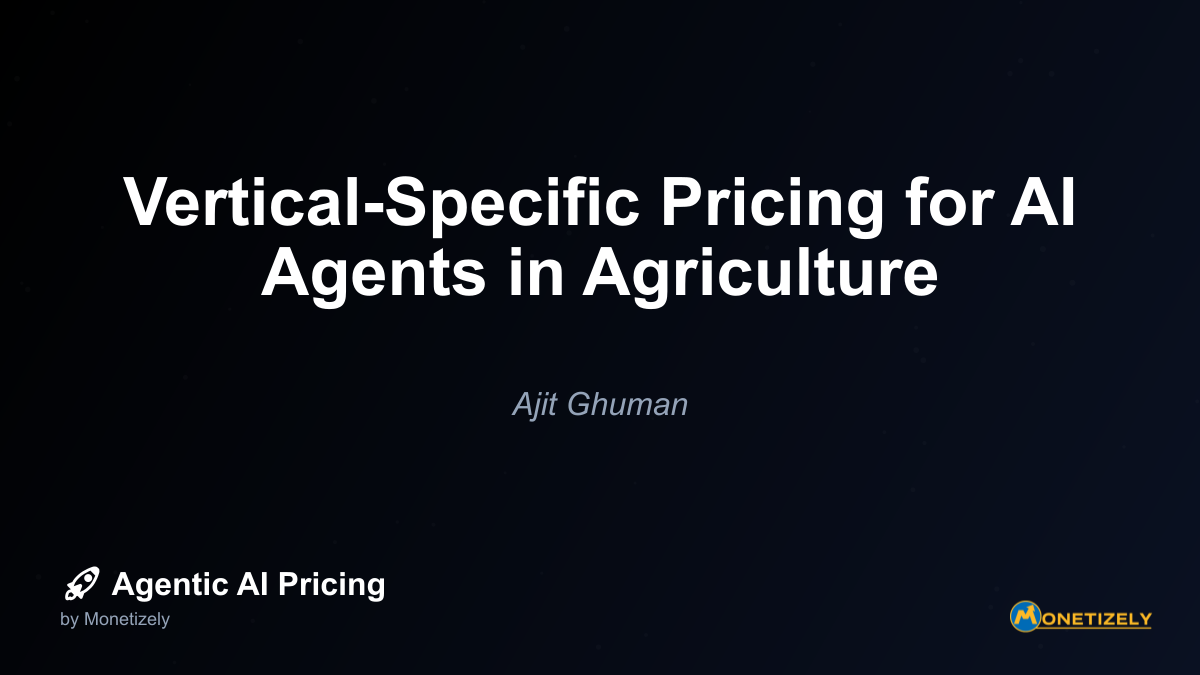· Ajit Ghuman · Industry-Specific · 13 min read
Vertical-Specific Pricing for AI Agents in Insurance
AI and SaaS Pricing Masterclass
Learn the art of strategic pricing directly from industry experts. Our comprehensive course provides frameworks and methodologies for optimizing your pricing strategy in the evolving AI landscape. Earn a professional certification that can be imported directly to your LinkedIn profile.
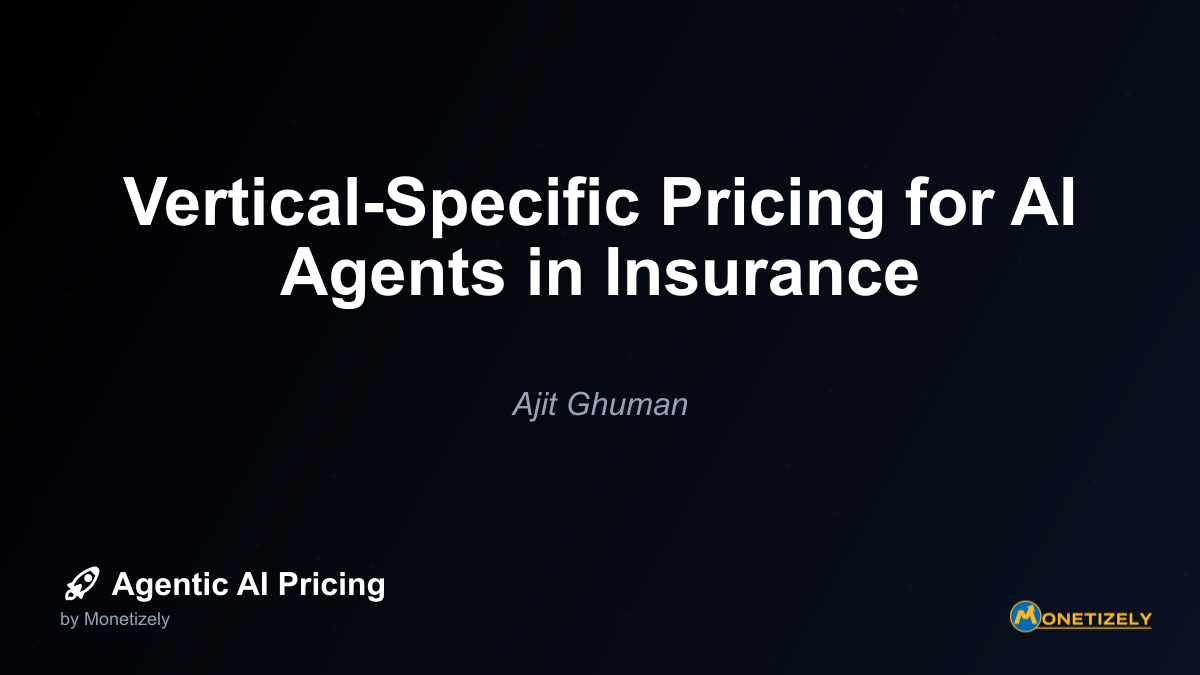
The insurance industry stands at a pivotal crossroads as artificial intelligence transforms traditional business models, operational workflows, and perhaps most significantly, pricing strategies. AI agents are redefining how insurance companies approach risk assessment, claims processing, underwriting, and policy management, creating unprecedented opportunities for precision, efficiency, and customer experience enhancement. However, developing effective pricing models for these AI solutions presents complex challenges that require careful consideration of industry-specific factors, regulatory requirements, and evolving customer expectations.
The Evolving Landscape of AI in Insurance
The insurance industry’s adoption of AI has accelerated dramatically in recent years, with the market valued at approximately $7.71 billion in 2024 and projected to reach over $35.7 billion by 2029, representing a compound annual growth rate (CAGR) of about 25.1%. This rapid expansion reflects insurance companies’ growing recognition of AI’s transformative potential across the entire value chain.
AI applications in insurance span multiple functional areas, each with unique pricing implications:
- Risk Assessment: AI models analyze vast datasets—including behavioral, demographic, and environmental data—to refine risk scores beyond traditional actuarial methods, enabling personalized and dynamic pricing.
- Claims Processing: AI-powered automation reduces manual review time, improves fraud detection, and accelerates payout times, with some implementations reducing cycle times by up to 73%.
- Underwriting: AI enables more accurate risk evaluation, with some systems improving underwriting accuracy by over 50% while dramatically reducing processing times.
- Policy Management: AI chatbots and virtual agents enhance policy servicing efficiency by handling queries, performing identity verification, and offering “next best action” recommendations to human agents.
As insurance executives consider implementing AI solutions, understanding the nuances of vertical-specific pricing models becomes essential for maximizing return on investment while maintaining competitive positioning in an increasingly technology-driven marketplace.
Current Market Trends in Insurance AI Pricing Models
The Shift from Static to Dynamic Pricing
Traditional insurance pricing relied on static actuarial models that categorized customers into broad risk pools based on historical data. AI has fundamentally disrupted this approach by enabling truly dynamic pricing that responds to real-time data inputs and evolving risk factors. According to recent industry research, AI-driven pricing models improve premium accuracy by approximately 53% compared to traditional methods.
This shift toward dynamic pricing is particularly evident in auto insurance, where telematics devices and smartphone apps collect real-time driving behavior data that AI algorithms analyze to adjust premiums based on actual risk exposure rather than demographic proxies. Similar trends are emerging in health insurance (through wearable devices), home insurance (via IoT sensors), and commercial lines (through integrated operational data).
Dominant Pricing Models for Insurance AI Solutions
The pricing of AI solutions in the insurance sector generally falls into several categories, each with distinct characteristics and applications:
1. Subscription-Based (SaaS) Models
Subscription pricing remains the most common model for AI platforms in insurance, typically structured as:
- Monthly or annual licenses based on company size or policy volume
- Tiered pricing determined by feature access and usage limits
- Per-user pricing for solutions focused on augmenting human agents
These subscription models typically range from $50,000 to $500,000+ annually, depending on the scale of implementation and the complexity of the AI solution. Enterprise-wide deployments for major insurers can reach into the millions for comprehensive AI platforms that address multiple functional areas.
2. Transaction-Based Pricing
Transaction-based models charge insurers based on actual usage of the AI system:
- Per-claim processing fees for claims automation solutions
- Per-policy pricing for AI-driven underwriting tools
- Per-interaction charges for customer service AI agents
Transaction fees typically range from $0.50 to $5 per instance, with volume discounts for high-utilization customers. This model aligns costs directly with usage and scales naturally with the insurer’s business volume.
3. Outcome-Based Pricing
Perhaps the most innovative approach, outcome-based pricing ties costs directly to measurable results:
- Percentage of fraud detected for fraud prevention AI
- Percentage of efficiency gains for process automation
- Percentage of loss ratio improvement for underwriting AI
This model creates strong alignment between vendor and insurer interests, as payment depends on demonstrable value creation. For example, Shift Technology’s fraud detection pricing indirectly ties to loss prevention impact, with some implementations delivering over $30 million in annual underwriting risk mitigation.
4. Hybrid Models
Many insurance AI vendors employ hybrid pricing approaches that combine elements of the above models:
- Base subscription fees plus transaction charges
- Minimum guaranteed payments with performance-based bonuses
- Tiered pricing with outcome-based incentives
These hybrid models help balance predictable revenue streams for vendors with performance incentives, while giving insurers some cost certainty with upside potential for exceptional results.
Segment-Specific AI Pricing Variations in Insurance
The insurance industry encompasses diverse segments with unique operational characteristics and AI application potential. These differences significantly impact how AI solutions are priced and deployed across various insurance verticals.
Auto Insurance
In auto insurance, AI pricing models heavily leverage telematics data and behavioral analytics:
- Telematics devices collecting driving behavior data typically cost insurers $50-$100 per device, with associated AI data processing fees
- AI-powered risk assessment enables usage-based insurance (UBI) with premiums that adjust based on actual driving patterns
- Claims assessment AI using computer vision for damage evaluation costs approximately $5-15 per claim processed
- Fraud detection systems often price based on a percentage of identified fraudulent claims
Tractable’s computer vision platform, for example, has accelerated vehicle damage appraisals and claims processing by 50% for Tokio Marine, demonstrating the significant efficiency gains possible through AI implementation.
Life Insurance
Life insurance AI focuses primarily on underwriting efficiency and risk accuracy:
- AI-enhanced underwriting using demographics, health records, and even genomics data can reduce processing times from weeks to days
- Mortality risk modeling improves underwriting accuracy by up to 54%
- Pricing typically reflects the high sensitivity of data with premium fees for advanced risk assessment capabilities
Zurich Insurance’s deployment of AI-driven underwriting in Australia demonstrates this value, reducing life insurance application processing for cases with mental health disclosures from 22 days to less than one day.
Health Insurance
Health insurance AI applications center on personalized risk assessment and preventive care:
- Wearable integration enables continuous health monitoring with dynamic premium adjustments
- Claims processing automation reduces administrative costs while accelerating payments
- Pricing often includes incentives for policyholders who participate in AI-driven wellness programs
- AI vendors typically charge based on covered lives rather than individual transactions
The pricing models in health insurance AI must navigate complex regulatory requirements while delivering measurable improvements in care coordination and cost management.
Property and Casualty Insurance
P&C insurers leverage AI for risk assessment, claims processing, and catastrophe modeling:
- IoT sensor integration enables real-time property monitoring and risk-adjusted pricing
- Catastrophe modeling using AI improves pricing accuracy for natural disaster coverage
- Claims automation reduces processing times by up to 70%, saving insurers an estimated $6.5 billion annually
- Pricing models often include setup fees for complex property data integration
Aviva’s partnership with Tractable exemplifies the value proposition, using AI-driven photo analysis to improve claims liability assessment and damage estimation, reducing assessment time by 23 days and shrinking customer complaints by 65%, ultimately saving £100 million.
Commercial Insurance
Commercial lines present unique challenges due to complex risk profiles and diverse data sources:
- AI risk assessment platforms typically command premium pricing due to the complexity of commercial exposures
- Pricing often scales based on premium volume rather than policy count
- Custom risk models may include additional development fees beyond standard platform costs
- Integration with industry-specific data sources may incur additional charges
Commercial insurance AI solutions tend to emphasize configurability and domain-specific expertise, with pricing that reflects these specialized capabilities.
Implementation Costs and ROI Considerations
Beyond the direct pricing of AI solutions, insurance companies must consider the total cost of implementation and expected return on investment when evaluating AI initiatives.
Implementation Cost Components
The full implementation of AI solutions in insurance typically involves several cost categories beyond software licensing:
Data preparation and integration: Ensuring clean, accessible data often requires significant investment, particularly when dealing with legacy systems and unstructured information like claims notes or medical records.
IT infrastructure upgrades: Many AI solutions require enhanced computing resources, secure cloud environments, and robust networking capabilities.
Staff training and change management: Effective AI implementation depends on user adoption, necessitating comprehensive training programs and organizational change management.
Compliance and regulatory adaptation: Insurance is highly regulated, requiring additional investment to ensure AI systems meet all applicable requirements.
Ongoing maintenance and model retraining: AI systems require continuous monitoring, refinement, and retraining to maintain accuracy as conditions change.
These implementation costs can range from 1.5 to 3 times the direct software costs, depending on the complexity of integration and organizational readiness.
ROI Metrics from Successful Implementations
Despite significant implementation costs, insurance companies are reporting compelling ROI from their AI investments:
- Claims automation using AI reduces processing time by up to 70%, saving insurers an estimated $6.5 billion annually
- Fraud detection enhanced by predictive analytics has improved recovery or avoidance of losses by 28%
- Operational efficiencies with virtual assistants handling 42% of customer interactions in 2025
- Underwriting accuracy improvements of 40-50% leading to better loss ratios
- Customer retention increases of 15-20% due to faster service and more personalized offerings
Shift Technology’s AI implementation with a major insurer yielded more than $15 incremental prevented loss per new policy, projecting over $30 million in annual underwriting risk mitigation. Similarly, Aviva’s AI partnership delivered a 23-day reduction in liability assessment, 30% improvement in routing accuracy, and £100 million in savings.
These metrics demonstrate that while AI implementation requires significant investment, the returns can be substantial across multiple dimensions of insurance operations.
Technical Considerations for AI Pricing in Insurance
The technical architecture and capabilities of AI solutions significantly influence their pricing and value proposition in the insurance context.
Data Quality and Integration Challenges
AI performance depends heavily on data quality, creating several technical considerations that impact pricing:
- Legacy system integration often requires custom connectors or middleware, adding to implementation costs
- Data cleansing and normalization may necessitate additional professional services
- External data sources (weather, traffic, property records) may incur separate licensing fees
- Real-time data processing capabilities command premium pricing due to infrastructure requirements
Insurers with modern, well-integrated data ecosystems may qualify for preferential pricing from AI vendors, as implementation costs and time-to-value are typically lower.
Model Transparency and Explainability
Regulatory requirements and customer trust concerns make AI explainability essential in insurance:
- Explainable AI features often command premium pricing due to the additional developmental complexity
- Audit trail capabilities for regulatory compliance add to system costs
- Model documentation and transparency tools may be priced as add-on features
Shift Technology, for example, emphasizes 100% explainability for regulatory and audit compliance, which influences its pricing structure but delivers essential value for insurance applications.
Scalability and Performance Considerations
Insurance operations often involve high transaction volumes and peak processing periods:
- Elastic scaling capabilities may incur additional costs based on usage patterns
- Performance guarantees (SLAs) for high-volume periods like catastrophe response
- Multi-tenant vs. dedicated infrastructure options affect pricing and performance
Cloud-based AI solutions typically offer more flexible scaling options but may include usage-based components that affect total cost of ownership.
Security and Compliance Requirements
Insurance data is highly sensitive, creating stringent security requirements:
- Enhanced security features often command premium pricing
- Compliance certifications (SOC 2, HIPAA, GDPR) are prerequisites for insurance deployments
- Data residency options for international operations add complexity and cost
These technical factors create significant variation in AI solution pricing based on the specific requirements of insurance implementations.
The Impact of AI on Insurance Premium Pricing
Beyond the pricing of AI solutions themselves, artificial intelligence is fundamentally transforming how insurers price their products for consumers and businesses.
Dynamic and Personalized Premium Pricing
AI enables unprecedented precision in risk assessment and premium calculation:
- Real-time risk evaluation allows premiums to adjust based on changing conditions
- Behavioral pricing rewards risk-reducing behaviors (safe driving, healthy lifestyles)
- Micro-segmentation creates highly personalized pricing based on individual risk profiles
- Continuous underwriting replaces static annual renewal processes
This shift toward dynamic, personalized pricing represents perhaps the most profound impact of AI on the insurance industry, potentially disrupting traditional pooled-risk business models.
Competitive Pricing Intelligence
AI also enhances insurers’ ability to optimize pricing relative to market conditions:
- Competitive rate analysis identifies optimal price points across customer segments
- Price elasticity modeling predicts customer response to premium changes
- Strategic pricing automation adjusts rates in response to market movements
- Customer lifetime value optimization balances short-term revenue against long-term profitability
These capabilities enable more sophisticated pricing strategies that maximize profitability while maintaining market competitiveness.
Claims Cost Prediction and Premium Alignment
AI improves the accuracy of claims cost forecasting, enabling better premium alignment:
- Predictive claims modeling anticipates future loss patterns
- Early intervention identification reduces ultimate claim costs
- Subrogation opportunity detection increases recovery rates
- Fraud pattern recognition reduces leakage
By more accurately predicting claims costs, AI allows insurers to set premiums that better reflect actual risk exposure, potentially reducing pricing volatility and improving profitability.
Regulatory and Ethical Considerations in Insurance AI Pricing
The insurance industry operates in a highly regulated environment, creating unique considerations for AI pricing and implementation.
Regulatory Compliance Requirements
AI systems in insurance must navigate complex regulatory frameworks:
- Anti-discrimination requirements prohibit unfair pricing based on protected characteristics
- Rate filing regulations in many jurisdictions require approval of AI-influenced pricing models
- Model documentation mandates ensure transparency in premium determination
- Consumer disclosure requirements may necessitate explanation of AI-driven decisions
These regulatory considerations add complexity to AI implementation and may influence pricing models by requiring additional features or safeguards.
Ethical Considerations in AI-Driven Pricing
Beyond regulatory compliance, insurers must address ethical questions raised by AI-driven pricing:
- Algorithmic bias mitigation ensures fair treatment across customer segments
- Privacy and consent frameworks for data collection and analysis
- Transparency in decision-making to maintain customer trust
- Accessibility considerations to prevent digital discrimination
These ethical considerations are increasingly important as AI systems gain autonomy and influence over pricing decisions that affect consumers’ financial well-being and access to essential insurance products.
Balancing Personalization and Risk Pooling
AI-driven personalization challenges the fundamental insurance principle of risk pooling:
- Extreme personalization could make insurance unaffordable for high-risk individuals
- Regulatory guardrails may limit the degree of premium differentiation
- Social responsibility considerations in pricing essential coverage types
- Balance between actuarial fairness and social equity
Insurance companies must navigate these tensions as they implement AI-driven pricing strategies, potentially influencing how they evaluate and price AI solutions based on regulatory compatibility and ethical alignment.
Future Trends in Insurance AI Pricing (2025-2030)
Looking ahead, several emerging trends will shape the evolution of AI pricing in the insurance industry over the next five years.
Embedded Insurance and Point-of-Sale Integration
AI is enabling the seamless integration of insurance into other purchase experiences:
- API-driven insurance pricing embedded in e-commerce, travel, and automotive platforms
- Real-time risk assessment at the point of sale or service
- Contextual insurance offerings tailored to specific activities or purchases
- Frictionless buying experiences powered by AI underwriting
This trend will drive demand for AI solutions with robust API capabilities and real-time decision-making, potentially shifting pricing models toward transaction-based approaches that align with embedded distribution.
Climate Risk Modeling and ESG Integration
Environmental, social, and governance (ESG) factors are increasingly influencing insurance pricing:
- Climate risk assessment AI for property insurance pricing
- ESG rating integration into commercial insurance underwriting
- Sustainability incentives built into premium calculations
- Catastrophe modeling with climate change projections
As climate risks become more prominent, AI solutions that effectively model these complex factors will command premium pricing based on their ability to improve risk selection and pricing accuracy.
Multi-Agent AI Systems and Ecosystem Approaches
The future of insurance AI lies in interconnected systems rather than isolated applications:
- Collaborative AI agents handling different aspects of the insurance lifecycle
- Ecosystem integration with IoT, automotive, health, and smart home platforms
- Cross-functional AI coordination between underwriting, claims, and customer service
- API-driven interoperability enabling flexible system architecture
This trend may drive a shift toward platform pricing models that encompass multiple AI capabilities rather than point solutions with separate pricing structures.
Agentic AI and Advanced Autonomy
As AI systems become more autonomous, pricing models will evolve to reflect increased capabilities:
- Self-improving AI systems that continuously enhance their performance
- Autonomous decision-making within defined parameters
- Proactive risk management rather than reactive claims handling
- Human-AI collaboration models with clearly defined roles
The pricing of these advanced AI capabilities will likely reflect their increased autonomy and value creation potential, potentially moving further toward outcome-based models that reward tangible business impact.
Data
Co-Founder & CEO
Ajit is the author of Price To Scale, a top book on SaaS Pricing and is the Founder of Monetizely. Ajit has led and worked in pricing and product marketing at firms like Twilio, Narvar and Medallia. His work has been featured in Forbes and VentureBeat. Ajit regularly consults with software companies from Seed stage to post-IPO on pricing strategy. Ajit is also a highly-rated co-instructor for 'The Art of SaaS Pricing and Monetization' on Maven.
Pricing Strategy Audit
Let our experts analyze your current pricing strategy and identify opportunities for improvement. Our data-driven assessment will help you unlock untapped revenue potential and optimize your AI pricing approach.

